Tourism statistics - nights spent at tourist accommodation establishments
Data extracted in September 2024.
Planned article update: 16 January 2025.
Highlights
780 million nights spent at tourist accommodation establishments in the EU in the second quarter of 2024, up by 0.2% compared with the same period in 2023.
Hotel nights grew by 4.4 million in the second quarter of 2023 and approached half a billion nights spent.
EU tourism nights reach a record 1.2 billion nights in the first year half of 2024 (+26.6 million nights).
Quaterly nights spent 2011-2024, by origin of guest
This article focuses on the short-term evolutions in the nights spent in tourist accommodation in the European Union (EU). The data from the most recent reference period available are compared with those of the same period of the previous year. The current article discusses the data for the second quarter of 2024 (and the first half of 2024).
Full article
780 million tourism nights spent in the second quarter of 2024
In the second quarter of 2024, 780.1 million nights were spent in EU tourist accommodation (see Table 1). This corresponds to 1.3 million more nights (+0.2 %) than those spent in the second quarter of last year. This modest increase, and a drop in 10 EU countries compared with the second quarter of 2023, can partly be linked to the busy Easter weekend falling in most countries just outside the second quarter this year (the last weekend of March, whereas in 2023 Easter fell in April). Double-digit increases were recorded in Luxembourg (+22.2 %) and Malta (+12.3 %) (see Figure 1). In absolute figures, the biggest increases were observed in Spain (+4.5 million nights), and Greece (+1.5 million).
During the second quarter, the number of nights increased as the summer season approached. From 193.6 million nights spent in April, over 272.1 million in May to 314.5 million in June 2024. Comparing with the same months of the previous year, April showed the most significant drop (-18.5 million nights, -8.7 %). May recorded 19.9 million nights more compared to one year earlier (+7.9 %), June was relatively stable (-182 thousand nights spent, -0.1 %)
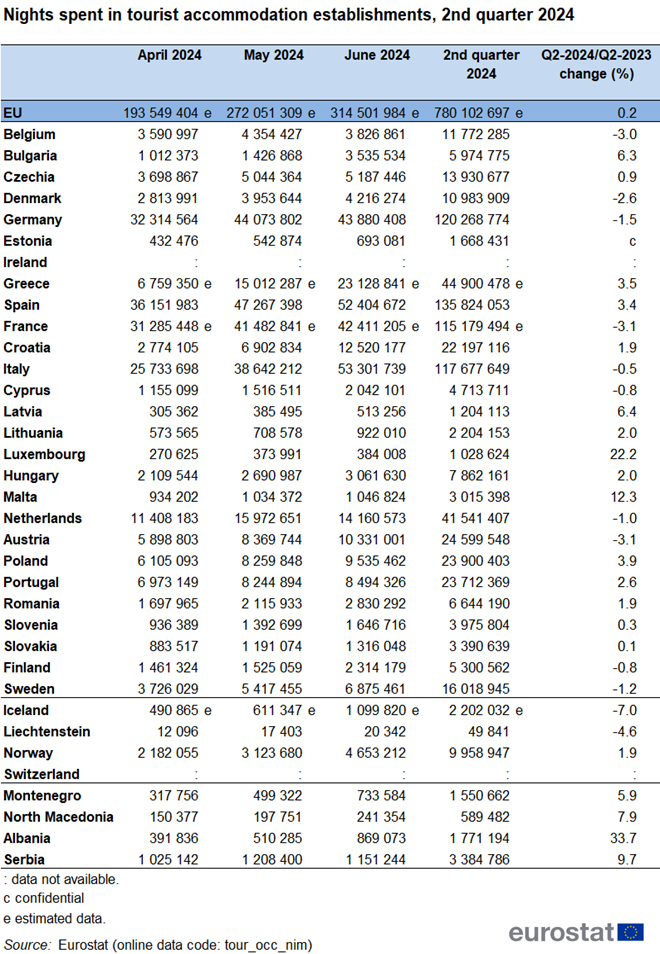
Source: Eurostat (tour_occ_nim)
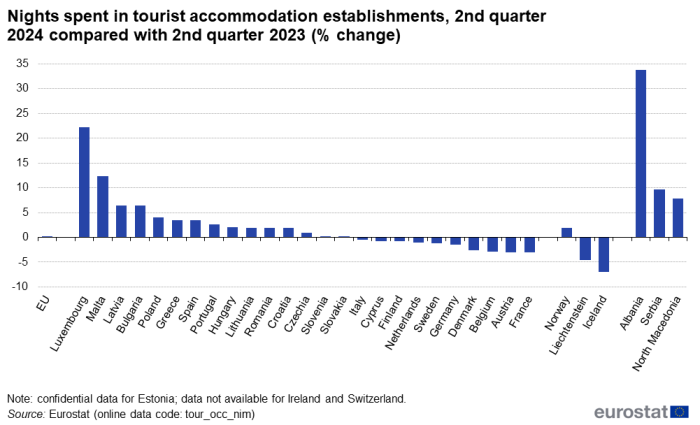
Source: Eurostat (tour_occ_nim)
Strong growth of international tourism in the second quarter
Looking at the breakdown by origin of the guest, in the second quarter of 2024, compared with the second quarter of 2023, international tourism (+11.5 million nights, +3.1 %) induced the overall growth by 0.2 %, whereas domestic tourism recorded a decrease (-10.2 million nights, -2.5 %) (see Table 2). Nights spent by foreign visitors as well as nights spent by domestic visitors in the second quarter exceeded the 2019 level, showing both market segments have now fully recovered from the pandemic.
In the second quarter, international tourism recovered particularly strongly, by 10 % or more, in Luxembourg (+23.8 %), Malta (+13.3 %) and Romania (+10.5 %) (see Figure 2). More than half of the international nights spent in the second quarter of 2024 (198.2 million out of 382.5 million) were observed in Spain (89.5 million), Italy (69.5 million) and Greece (39.1 million). An increase in international tourism was observed in most EU members, except the Netherlands -5.73 %), Austria -4.3 %), Belgium (-1.9 %), France (-1.7 %) and Cyprus (-0.3 %).
In absolute terms, domestic tourism was the predominant contributor (397.6 million nights) to the 780.1 million nights spent in tourist accommodation across the EU in the second quarter of 2024. Between April and June, 97.8 million nights were spent in Germany by residents of that country (-3.2 % compared with the second quarter of 2023), France recorded 79.3 million nights spent by residents (-3.1 %). In 16 out of 25 EU Member States for which data is available, fewer domestic tourism nights were recorded in the second quarter of 2024 than in the same period in 2023.

Source: Eurostat (tour_occ_nim)
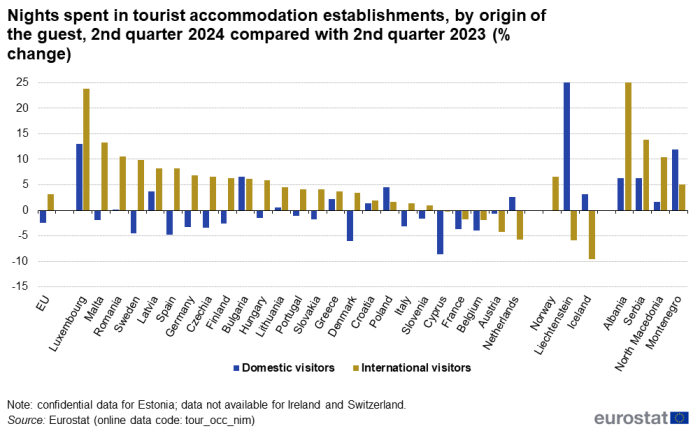
Source: Eurostat (tour_occ_nim)
Hotel nights increased by 4.4 million in the second quarter, approaching 500 million nights
Not all types of tourist accommodation showed increases for the second quarter compared with the same period in 2022 (see Table 3). 498 million nights were spent in hotels and similar accommodation, an increase by 0.9 % (+4.4 million nights). This segment accounted for 63.8 % of tourist accommodation). Nights spent at holiday and other-short stay accommodation (representing 22.6 % of the tourist accommodation market) increased by 1.1 %, while the smaller segment of campsites (accounting for 13.6 % of nights spent in the second quarter) decreased by 4.6 %.
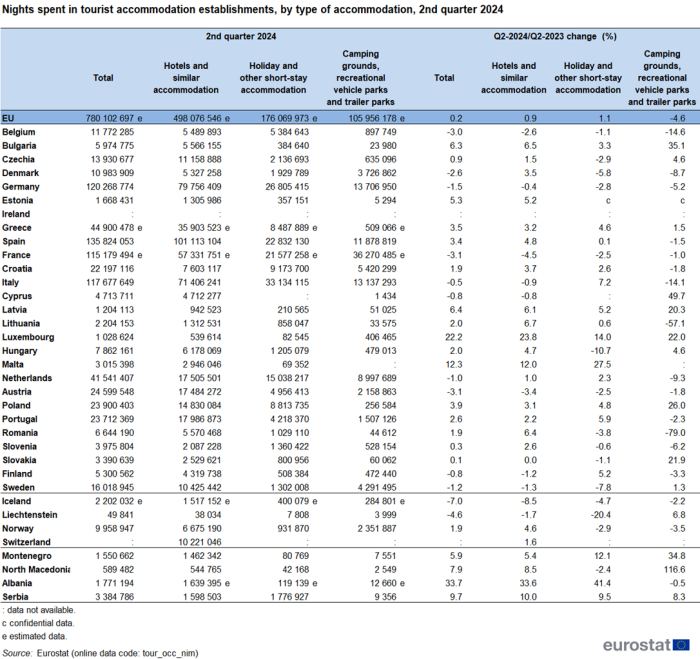
Source: Eurostat (tour_occ_nim)

Source: Eurostat (tour_occ_nim)
EU tourism at a high in the first half of 2024
In the first half of 2024, 1.2 billion nights were spent in tourist accommodation in the EU, the highest figure ever observed for the first two quarters of a year (see Table 4). This marked an increase by 26.6 million nights compared with the first half of 2023 (+2.2 %) and 50.8 million extra nights compared with the first half year of pre-pandemic 2019 (+4.3 %). In the first six months of the year, foreigners spent 586.0 million nights in tourist accommodation establishments in EU countries, compared with 556.8 million nights in the first half of 2023, a strong growth by +5.3 %. Nights spent by domestic visitors in the first half of 2024, on the contrary, slightly contracted by 0.5 % (646.7 million nights, or 3 million less than the same period one year earlier). Looking at the country data, all EU members for which data is available saw in 2024 an increase in nights spent compared with the first half of 2023, excepting France (-1.1 %), Belgium -0.4 %) and Sweden (-0.2 %) (see Figure 4). While a significant number of countries saw a decrease in domestic nights spent, all EU countries noted an increase in nights spent by international visitors. The biggest contributors, in absolute terms, to the overall increase by 26.6 million nights compared with the first half of 2023, were Spain (+8.1 million, reaching 211.4 million nights spent), Germany (+4.7 million, reaching 195.7 million) and Italy (+3.3 million, reaching 179.0 million). In all three cases, the growth was predominantly driven by international tourism (in the case of Spain and Italy, growing international tourism even compensated a drop in domestic tourism in the first half of the year).
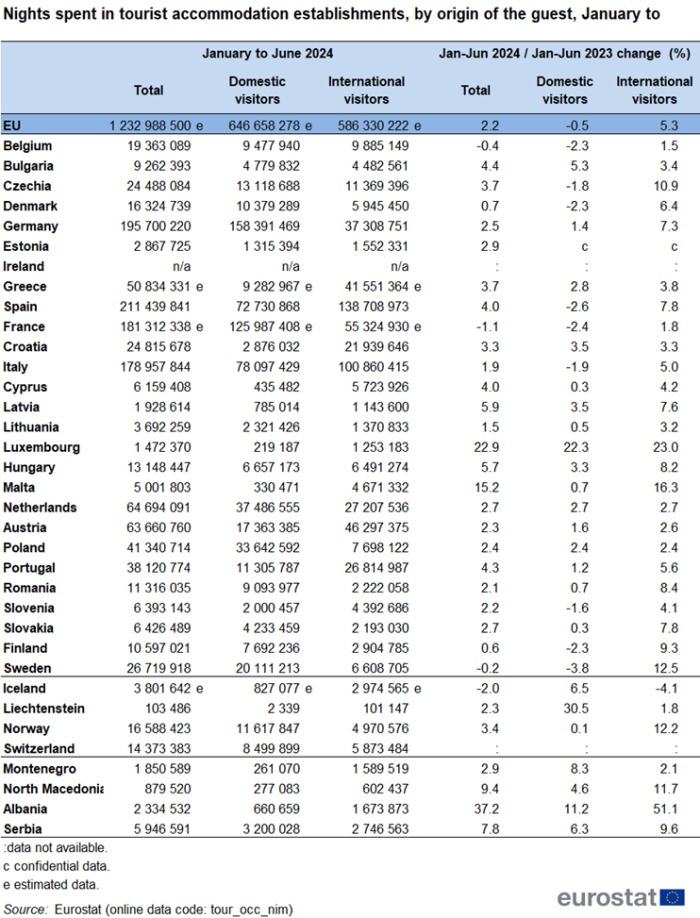
Source: Eurostat (tour_occ_nim)
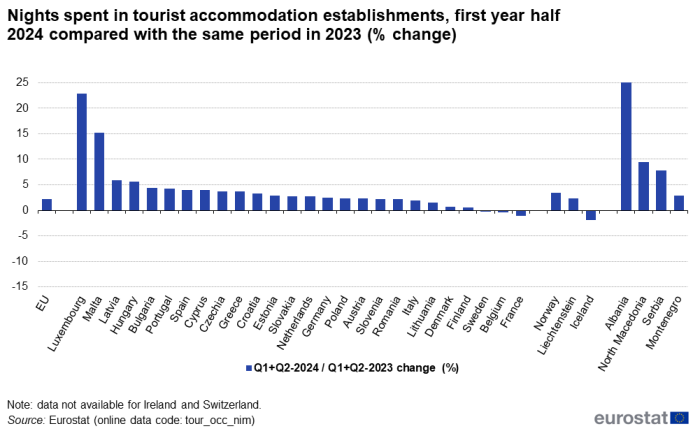
Source: Eurostat (tour_occ_nim)
Source data for tables and graphs
Data sources
This article presents the short-term trends in nights spent in tourist accommodation in the EU, analysing monthly data provided by Member States.
For the year-to-year evolution of the number of nights spent in tourist accommodation and a detailed analysis of 2022 annual data, see Tourism statistics - annual results for the accommodation sector.
Eurostat also publishes separate series on platform tourism, re-using privately held data obtained directly from four major international platforms. For the most recent results, see the article Short-stay accommodation offered via online collaborative economy platforms - monthly data.
Context
The EU is a major tourist destination, with four Member States among the world's top ten destinations for holidaymakers, according to UNWTO[1] data. Tourism is an important activity in the EU which contributes to employment and economic growth, as well as to the development of rural, peripheral or less-developed areas. These characteristics drive the demand for reliable and harmonised statistics on this activity, as well as within the wider context of regional policy and sustainable development policy areas.
Direct access to
- Tourism (t_tour)
- Capacity and occupancy of tourist accommodation establishments (ESMS metadata file — tour_occ_esms)
- Regulation (EU) No 692/2011 of 6 July 2011 concerning European statistics on tourism and repealing Council Directive 95/57/EC.
- Agenda for a sustainable and competitive European tourism (Communication from the European Commission, October 2007)